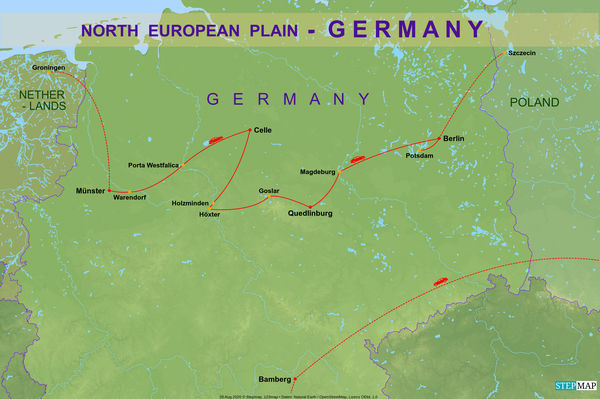North European Plain 34 - Germany/Bamberg 1 - Southern part of Old Town
May 22, 2021 11:01:08 #
The following final 3 sets of Germany covering Bamberg/Bavaria are a bit out of sequence with my other pictures. After Magdeburg, we actually drove up to Berlin, then into Poland and on the way back crossed into Germany once again and visited Bamberg. Since these Bamberg pictures do not fit into the Berlin or Poland topic, I decided to add them here at the end of the general Northern Germany batch. Here is what our friends at Wiki tell us about this treasure of a town:
INTRODUCTION
BAMBERG is a town in Upper Franconia on the river Regnitz close to its confluence with the river Main. The town dates back to the 9th century. Cited as one of Germany's most beautiful towns, its old town has been a UNESCO World Heritage Site since 1993, with Bamberg being home to Europe's largest intact old city wall. From the 10th century onwards, Bamberg became a key link with the Slav people, notably those of Poland and Pomerania. It experienced a period of great prosperity from the 12th century onwards. The town's architecture from this period strongly influenced that in Northern Germany and Hungary.
HISTORY
During the post-Roman centuries of Germanic migration and settlement, the region was inhabited mostly by Slavs. The town, first mentioned in 902, grew up by the castle Babenberch which gave its name to the Babenberg family. The area was Christianized chiefly by the monks of the Benedictine Fulda Abbey, and the land belonged to the Diocese of Würzburg. In 1007, Holy Roman Emperor Henry II made Bamberg a family inheritance, the seat of a separate diocese. The Emperor's purpose was to make the Diocese of Würzburg less unwieldy in size and to give Christianity a firmer footing in the districts of Franconia, east of Bamberg. In 1008, after long negotiations with the Bishops of Würzburg and Eichstätt, who had to cede portions of their dioceses, the boundaries of the new diocese were defined. Henry II ordered the building of a new cathedral, which was consecrated in 1012. In 1017 Henry also founded Michaelsberg Benedictine Abbey on the "Mount St. Michael" near Bamberg, for the training of the clergy. The emperor and his wife Kunigunde gave large possessions to the new diocese, and it received many privileges out of which grew the secular power of the bishop. Pope Benedict VIII visited Bamberg in 1020 to meet Henry II for discussions concerning the Holy Roman Empire. While he was here he placed the diocese in direct dependence on the Holy See. For a short time Bamberg was the center of the Holy Roman Empire. Henry and Kunigunde were buried in the cathedral.
From the middle of the 13th century on, the bishops were princes of the Empire and ruled Bamberg, overseeing the construction of monumental buildings. The old Bishopric of Bamberg was composed of an unbroken territory extending in a northeasterly direction to the Franconian Forest, and possessed in addition estates in the Duchies of Carinthia and Salzburg, in the Nordgau (the present Upper Palatinate), in Thuringia, and on the Danube. By the changes resulting from the Reformation, the territory of this see was reduced nearly one half in extent. The witch trials of the 17th century claimed about one thousand victims in Bamberg, reaching a climax between 1626 and 1631. In 1759, the possessions of the diocese situated in Austria were sold to that state. When the secularization of church lands took place in 1802, the diocese covered 3,305 km² (1,276 sq mi) and had a population of 207,000. Bamberg thus lost its independence in 1802, becoming part of Bavaria in 1803. After a communist uprising took control over Bavaria in the years following WW I, the state government fled to Bamberg and stayed there for almost two years before the Bavarian capital of Munich was retaken. The first republican constitution of Bavaria was passed in Bamberg, becoming known as the Bamberg Constitution. Following WWII, Bamberg was an important base for the Bavarian, German, and then American military stationed at Warner Barracks, closing only in 2014. In 1973, the town celebrated the 1,000th anniversary of its founding.
ATTRACTIONS
~ OLD TOWN HALL - Built in the middle of the Regnitz river, accessible by two bridges. The Old Town Hall is quite a curiosity: The frescoes that adorn the facades are as amazing as the story behind the building's construction. According to legend the bishop of Bamberg did not grant the citizens any land for the construction of a town hall. This prompted the townsfolk to ram stakes into the river Regnitz to create an artificial island, on which they built the town hall they so badly wanted. The Old Town Hall's frescoes never fail to impress as they lend the facades a three-dimensional quality achieved with trompe d'oeil architecture. A special detail is a continual source of mirth among tourists: The leg of a cherub protrudes out of the wall as a sculpture.
~ CHURCH OF OUR DEAR LADY - Located on the Kaulberg. This church, which is called "Upper Parish" by the locals, is Bamberg's only purely gothic church. The simple nave was added 50 years after the late gothic choir whose foundations date from 1375. The wedding portal is a striking feature with its gothic statues. The church interior with a nave and two aisles contains baroque furnishings. The painting "The Ascension of Mary" by Tintoretto is a particularly valuable work of art. The church has recently been restored to its original pure Gothic style.
~ SMOKED BEER (RAUCHBIER) - Bamberg is well-known for its smoked "Rauchbier" and is home to nine breweries and one brewpub, Ambräusianum and some new smaller breweries. Every August there is a five-day "Sandkerwa", a kirmess celebrated with beers.
--------------------------------------------------------------------------------------------------------------------------------
We will visit Bamberg in three sets. This first set covers the part south of the city hall and brings you among others an eclectic mix of the two main elements of the city: Religious art & buildings and also restaurants and items related to beer.
Notes
TRIP INFO: Set # 1 provides a brief introduction, maps and information for the entire series. Find it at:
https://www.uglyhedgehog.com/t-693834-1.html
EARLIER POSTS of this series: Access my topic list, the new posts are listed in reverse chronological order:
https://www.uglyhedgehog.com/user-topic-list?usernum=45105
Thank you for visiting, I recommend viewing the downloads and look forward to your comments and questions.
.
INTRODUCTION
BAMBERG is a town in Upper Franconia on the river Regnitz close to its confluence with the river Main. The town dates back to the 9th century. Cited as one of Germany's most beautiful towns, its old town has been a UNESCO World Heritage Site since 1993, with Bamberg being home to Europe's largest intact old city wall. From the 10th century onwards, Bamberg became a key link with the Slav people, notably those of Poland and Pomerania. It experienced a period of great prosperity from the 12th century onwards. The town's architecture from this period strongly influenced that in Northern Germany and Hungary.
HISTORY
During the post-Roman centuries of Germanic migration and settlement, the region was inhabited mostly by Slavs. The town, first mentioned in 902, grew up by the castle Babenberch which gave its name to the Babenberg family. The area was Christianized chiefly by the monks of the Benedictine Fulda Abbey, and the land belonged to the Diocese of Würzburg. In 1007, Holy Roman Emperor Henry II made Bamberg a family inheritance, the seat of a separate diocese. The Emperor's purpose was to make the Diocese of Würzburg less unwieldy in size and to give Christianity a firmer footing in the districts of Franconia, east of Bamberg. In 1008, after long negotiations with the Bishops of Würzburg and Eichstätt, who had to cede portions of their dioceses, the boundaries of the new diocese were defined. Henry II ordered the building of a new cathedral, which was consecrated in 1012. In 1017 Henry also founded Michaelsberg Benedictine Abbey on the "Mount St. Michael" near Bamberg, for the training of the clergy. The emperor and his wife Kunigunde gave large possessions to the new diocese, and it received many privileges out of which grew the secular power of the bishop. Pope Benedict VIII visited Bamberg in 1020 to meet Henry II for discussions concerning the Holy Roman Empire. While he was here he placed the diocese in direct dependence on the Holy See. For a short time Bamberg was the center of the Holy Roman Empire. Henry and Kunigunde were buried in the cathedral.
From the middle of the 13th century on, the bishops were princes of the Empire and ruled Bamberg, overseeing the construction of monumental buildings. The old Bishopric of Bamberg was composed of an unbroken territory extending in a northeasterly direction to the Franconian Forest, and possessed in addition estates in the Duchies of Carinthia and Salzburg, in the Nordgau (the present Upper Palatinate), in Thuringia, and on the Danube. By the changes resulting from the Reformation, the territory of this see was reduced nearly one half in extent. The witch trials of the 17th century claimed about one thousand victims in Bamberg, reaching a climax between 1626 and 1631. In 1759, the possessions of the diocese situated in Austria were sold to that state. When the secularization of church lands took place in 1802, the diocese covered 3,305 km² (1,276 sq mi) and had a population of 207,000. Bamberg thus lost its independence in 1802, becoming part of Bavaria in 1803. After a communist uprising took control over Bavaria in the years following WW I, the state government fled to Bamberg and stayed there for almost two years before the Bavarian capital of Munich was retaken. The first republican constitution of Bavaria was passed in Bamberg, becoming known as the Bamberg Constitution. Following WWII, Bamberg was an important base for the Bavarian, German, and then American military stationed at Warner Barracks, closing only in 2014. In 1973, the town celebrated the 1,000th anniversary of its founding.
ATTRACTIONS
~ OLD TOWN HALL - Built in the middle of the Regnitz river, accessible by two bridges. The Old Town Hall is quite a curiosity: The frescoes that adorn the facades are as amazing as the story behind the building's construction. According to legend the bishop of Bamberg did not grant the citizens any land for the construction of a town hall. This prompted the townsfolk to ram stakes into the river Regnitz to create an artificial island, on which they built the town hall they so badly wanted. The Old Town Hall's frescoes never fail to impress as they lend the facades a three-dimensional quality achieved with trompe d'oeil architecture. A special detail is a continual source of mirth among tourists: The leg of a cherub protrudes out of the wall as a sculpture.
~ CHURCH OF OUR DEAR LADY - Located on the Kaulberg. This church, which is called "Upper Parish" by the locals, is Bamberg's only purely gothic church. The simple nave was added 50 years after the late gothic choir whose foundations date from 1375. The wedding portal is a striking feature with its gothic statues. The church interior with a nave and two aisles contains baroque furnishings. The painting "The Ascension of Mary" by Tintoretto is a particularly valuable work of art. The church has recently been restored to its original pure Gothic style.
~ SMOKED BEER (RAUCHBIER) - Bamberg is well-known for its smoked "Rauchbier" and is home to nine breweries and one brewpub, Ambräusianum and some new smaller breweries. Every August there is a five-day "Sandkerwa", a kirmess celebrated with beers.
--------------------------------------------------------------------------------------------------------------------------------
We will visit Bamberg in three sets. This first set covers the part south of the city hall and brings you among others an eclectic mix of the two main elements of the city: Religious art & buildings and also restaurants and items related to beer.
Notes
TRIP INFO: Set # 1 provides a brief introduction, maps and information for the entire series. Find it at:
https://www.uglyhedgehog.com/t-693834-1.html
EARLIER POSTS of this series: Access my topic list, the new posts are listed in reverse chronological order:
https://www.uglyhedgehog.com/user-topic-list?usernum=45105
Thank you for visiting, I recommend viewing the downloads and look forward to your comments and questions.
.
1 - View upriver to the buildings along the river Regnitz
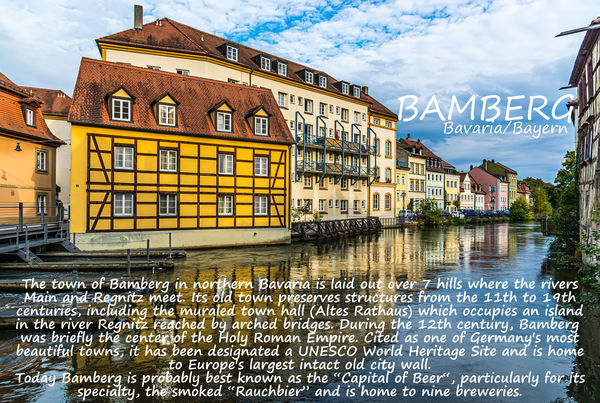
(Download)
2 - Restaurant Klosterbräu with staggered outside sitting platforms due to the slanting street, this is the oldest brew-place in Bamberg, existing since 1533
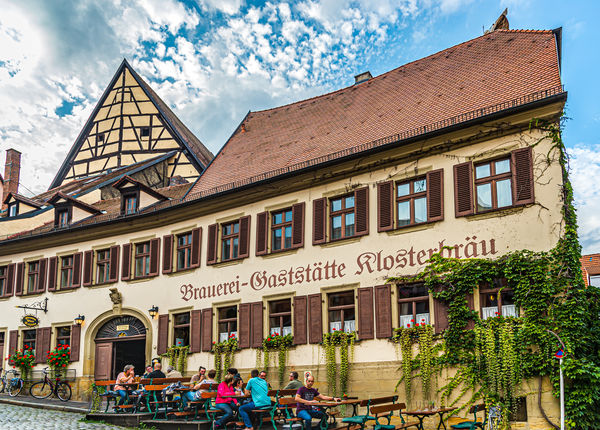
(Download)
3 - Detail of the storage house for the Klosterbräu beer, at the bottom the inscription: "Tithe house of the prince/bishop, built around 1500"
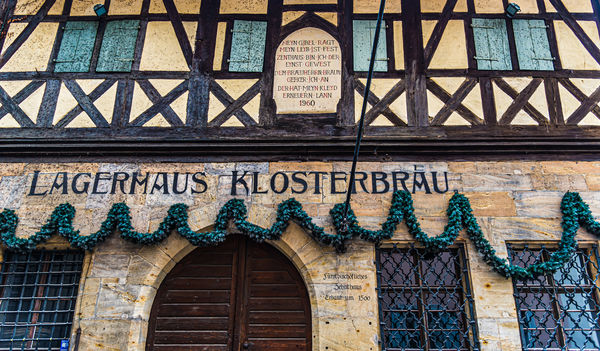
(Download)
4 - Inscription in German: My gable peaks, my body is solid, I was once a "tithe house", I belong to the brewer Braun, he let my robe be renewed - 1960
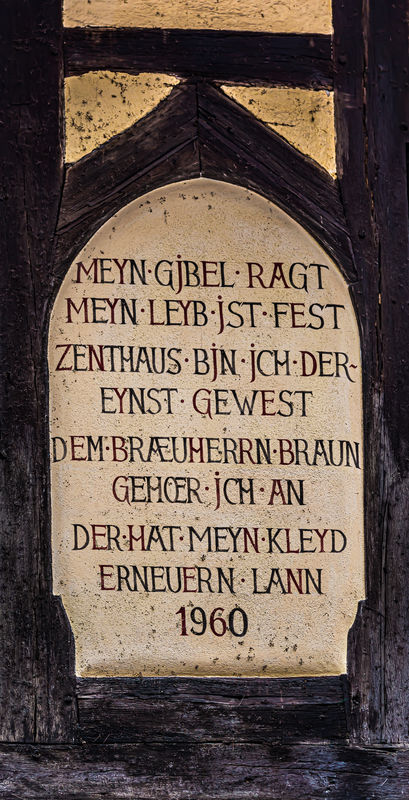
(Download)
5 - A cobble-stoned narrow lane with colorful houses
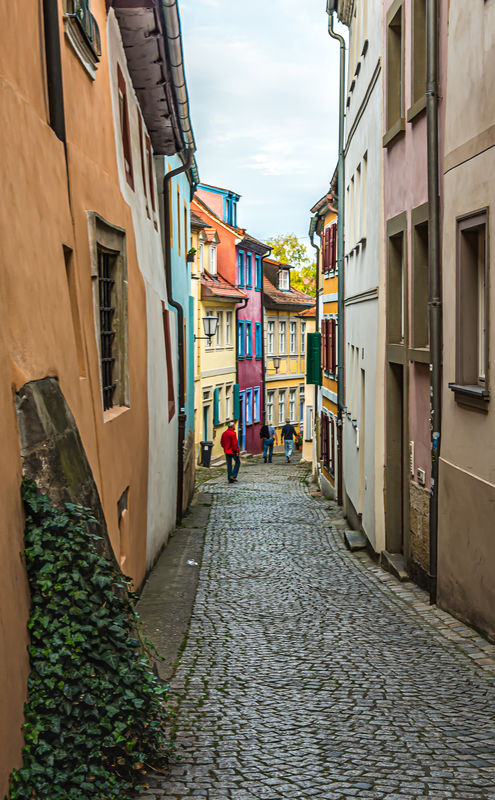
(Download)
6 - Statue of the Madonna and child in an alcove on the facade of the House of the Drum (Haus zur Trommel) on Judenstrasse 17
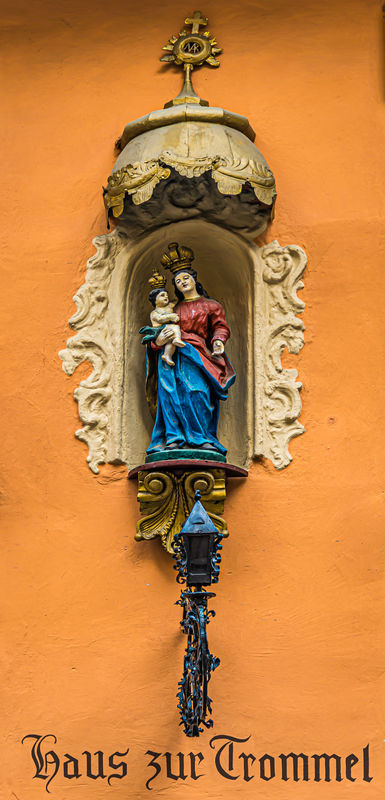
(Download)
7 - Restaurants on the Pfahlplätzchen square, at right a modern sculpture
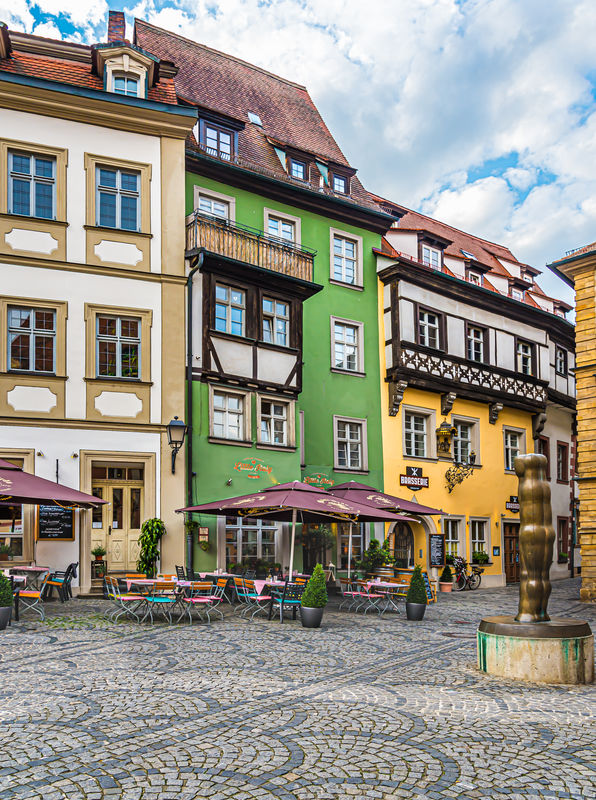
(Download)
8 - Church Our Dear Lady (Upper Parish) on the Kaulberg (1338)
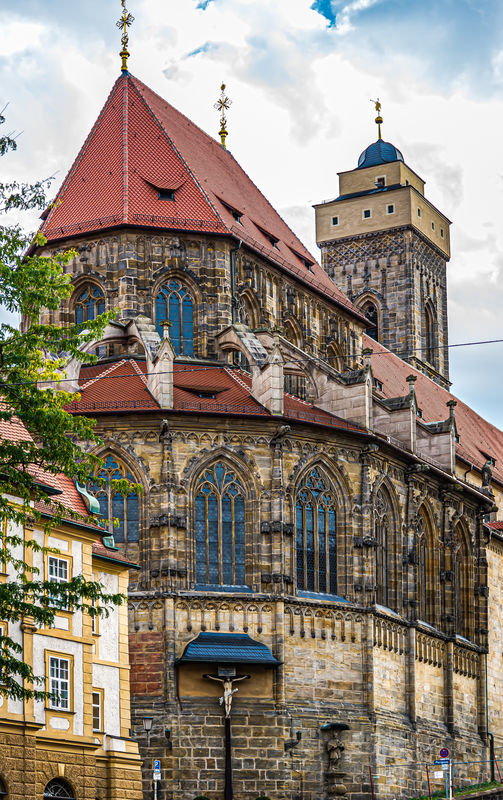
(Download)
9 - Sculpture in white and gold of a lady with angels at the corner of the Brudermühle Hotel
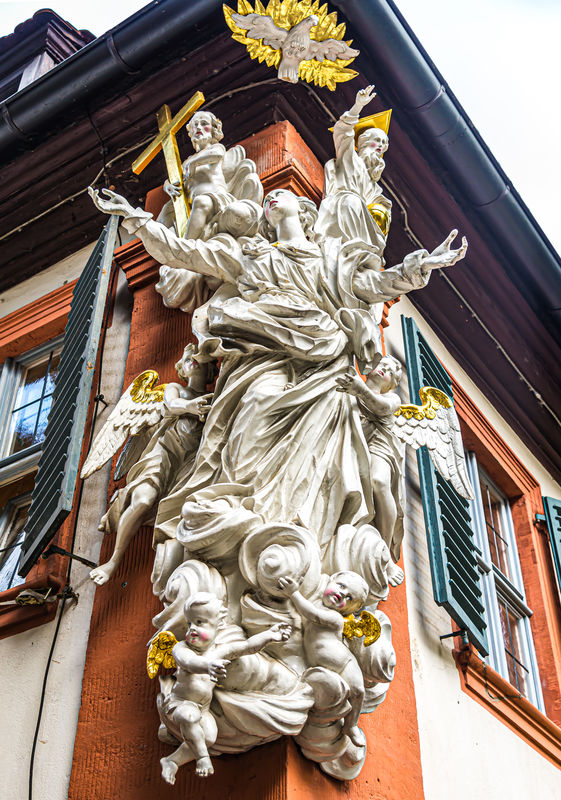
(Download)
10 - View upriver to the buildings along the river Regnitz with reflections, at left the Obere Mühlbrücke
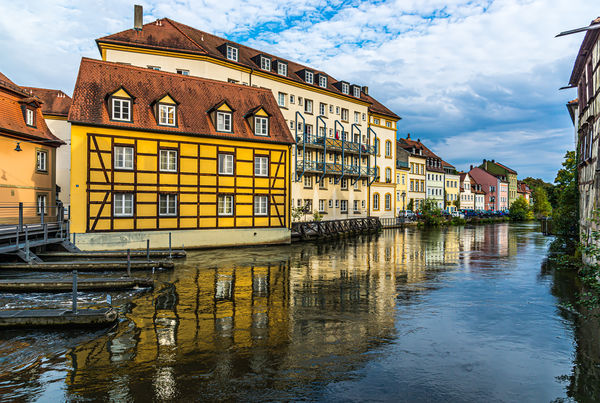
(Download)
May 22, 2021 11:02:04 #
May 22, 2021 11:06:24 #
weberwest wrote:
The following final 3 sets of Germany covering Bam... (show quote)
Your images are like Picture Postcards. The plus is your brief introduction, maps and information for the entire series.
May 22, 2021 11:23:32 #
jrcarpe
Loc: Jacksonville,AR
Of course Berlin is my favorite city in Germany since I served there from 1961 to 1963 but Germany is a beautiful country and has so much to offer those who will take the time to see all the beauty.
Bamberg, Hanover, Helmstedt, Dresden, Kassel, Wurtzburg,Nuremberg, Munich are worth a visit.
Bamberg, Hanover, Helmstedt, Dresden, Kassel, Wurtzburg,Nuremberg, Munich are worth a visit.
May 22, 2021 11:25:34 #
May 22, 2021 11:44:23 #
May 22, 2021 12:00:45 #
May 22, 2021 12:08:31 #
I didn't make it to Bamberg while I was in Germany. I should have. I really like the last image, Joe.
May 22, 2021 12:15:35 #
PixelStan77 wrote:
Your images are like Picture Postcards. The plus is your brief introduction, maps and information for the entire series.
Thank you very much Stan for your kind comment. I am very pleased that you are visiting my travelogue.
May 22, 2021 12:17:41 #
jrcarpe wrote:
Of course Berlin is my favorite city in Germany since I served there from 1961 to 1963 but Germany is a beautiful country and has so much to offer those who will take the time to see all the beauty.
Bamberg, Hanover, Helmstedt, Dresden, Kassel, Wurtzburg,Nuremberg, Munich are worth a visit.
Bamberg, Hanover, Helmstedt, Dresden, Kassel, Wurtzburg,Nuremberg, Munich are worth a visit.
Thank you for looking in on my tour, after two more sets in Bamberg, we will have an extensive look at Berlin.
May 22, 2021 12:18:38 #
gsmith051 wrote:
Thank you for sharing your tour. Nice set.
Thank you very much George for visiting my tour and your kind comment.
May 22, 2021 12:20:28 #
angler wrote:
Super set as always Joe.
Thank you very much Jim, I appreciate your participation in the tour and your kind comment!
May 22, 2021 12:21:08 #
May 22, 2021 12:23:14 #
kpmac wrote:
I didn't make it to Bamberg while I was in Germany. I should have. I really like the last image, Joe.
Thanks Ken, Bamberg definitely is a very nice town, but there are so many attractive places there, it would be very hard - and time consuming - to try to visit them all - I am still at it.......
May 22, 2021 18:42:45 #
If you want to reply, then register here. Registration is free and your account is created instantly, so you can post right away.

